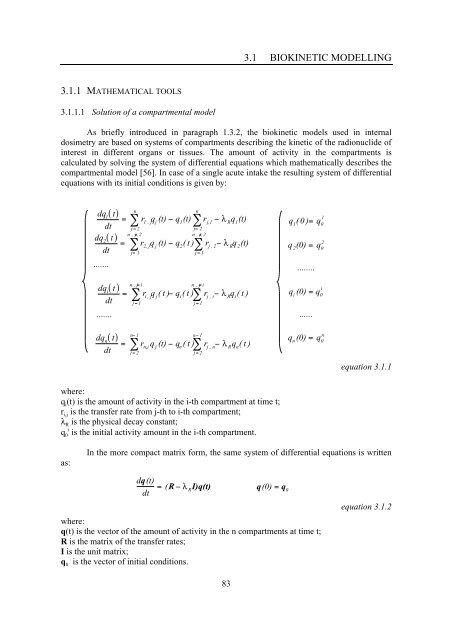Plutonium Biokinetics in Human Body A. Luciani - Kit-Bibliothek - FZK
Plutonium Biokinetics in Human Body A. Luciani - Kit-Bibliothek - FZK
Plutonium Biokinetics in Human Body A. Luciani - Kit-Bibliothek - FZK
Create successful ePaper yourself
Turn your PDF publications into a flip-book with our unique Google optimized e-Paper software.
3.1.1 MATHEMATICAL TOOLS<br />
3.1.1.1 Solution of a compartmental model<br />
83<br />
3.1 BIOKINETIC MODELLING<br />
As briefly <strong>in</strong>troduced <strong>in</strong> paragraph 1.3.2, the biok<strong>in</strong>etic models used <strong>in</strong> <strong>in</strong>ternal<br />
dosimetry are based on systems of compartments describ<strong>in</strong>g the k<strong>in</strong>etic of the radionuclide of<br />
<strong>in</strong>terest <strong>in</strong> different organs or tissues. The amount of activity <strong>in</strong> the compartments is<br />
calculated by solv<strong>in</strong>g the system of differential equations which mathematically describes the<br />
compartmental model [56]. In case of a s<strong>in</strong>gle acute <strong>in</strong>take the result<strong>in</strong>g system of differential<br />
equations with its <strong>in</strong>itial conditions is given by:<br />
where:<br />
qi(t) is the amount of activity <strong>in</strong> the i-th compartment at time t;<br />
ri,j is the transfer rate from j-th to i-th compartment;<br />
λR is the physical decay constant;<br />
i<br />
q0 is the <strong>in</strong>itial activity amount <strong>in</strong> the i-th compartment.<br />
as:<br />
dq1 t<br />
dt<br />
dq2 t<br />
dt<br />
.......<br />
dq i t<br />
dt<br />
.......<br />
dq n t<br />
dt<br />
n<br />
j 2<br />
n,j 2<br />
j 1<br />
n,j i<br />
j 1<br />
r 1,jq j(t)<br />
r 2, jq j (t)<br />
r i,jq j(t)<br />
n 1<br />
rn,j q j (t)<br />
j 2<br />
q 1(t) r j,1<br />
j 2<br />
n,j2<br />
equation 3.1.1<br />
In the more compact matrix form, the same system of differential equations is written<br />
dq(t)<br />
dt<br />
where:<br />
q(t) is the vector of the amount of activity <strong>in</strong> the n compartments at time t;<br />
R is the matrix of the transfer rates;<br />
I is the unit matrix;<br />
q 0 is the vector of <strong>in</strong>itial conditions.<br />
n<br />
q 2(t) r j,2<br />
j 1<br />
n,ji<br />
q i(t) r j,i<br />
j 1<br />
n 1<br />
q n(t) r j,n<br />
j 2<br />
λ Rq 1(t)<br />
λ Rq 2(t)<br />
λ Rq i(t)<br />
λ Rq n(t)<br />
(R λ RI)q(t) q(0) q 0<br />
1<br />
q1(0) q0 2<br />
q2(0) q0 ........<br />
i<br />
qi (0) q0 ......<br />
n<br />
qn(0) q0 equation 3.1.2












![{A1[]Sp - Bibliothek](https://img.yumpu.com/21908054/1/184x260/a1sp-bibliothek.jpg?quality=85)




